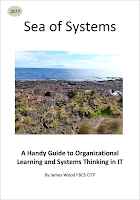
I have noticed that once decisions are made we often forge ahead even when we feel it might not be the right thing to do
Plus ça change, plus c'est la même chose
As the French say "the more it changes the more it remains the same"―one of the eternal challenges of managing change and one very good reason to turn to system dynamics and systems thinking as effective ways to understand and control the very real and insidious threat.
Insidious because the threat is often invisible and undetectable from within the system of change. More often than not we throw more assets and resources at it, with the attitude, "look, we've made the decision, we all agreed, now we'll bloody-well get on with it".
Brave and true to the cause, but sometimes, we just need to admit failure, accept failure and above all understand failure. It is in understanding failure that system dynamics and systems thinking come into their own.
Mapping out systemic influences
The first step in change or intervention is mapping out the systemic influences that could impact the system of change. When we talk about systems we are using the definition of system provided by Professor Alfredo Moscardini in his foreword to Sea of Systems, a system which can loosely be described as a set of objects that have a common purpose.
We are surrounded by systems, not just technological systems but systems of every kind, societal, political, ecosystems in nature. When we embark on a change or intervention we are surrounded by the system of change.
In this context systemic refers to any influence that is, has or may potentially impact the system, in any way whatsoever. You may be familiar with structured change management methodologies, where an impact assessment matrix is used to map-out impacts to business processes according to roles and business units.
These impacts are normally limited to areas such as tooling and skilling, however, when we conduct a systemic mapping analysis we must go much further and deeper, as well as forward and backward in time.
In order to create a solid understanding of our interventions we must build a multidimensional systems model that can be used to actually live-out each scenario for change. It is therefore very important to slowdown using reflective techniques and become aware of the system as it really is.
Without the noise and the external pressure to change, we need a clear and unwavering sense of clarity to be able to discern the reality of our systems. Take a BIG step backwards and take some DEEP breaths.
Inside-out → outside-in
When we are in the system of change it is sometimes very hard to take a different perspective and all too easy to keeping forging ahead, absolutely determined in our conviction to succeed. Sometimes however we simply must take stock, and typically we look inwards, with the attitude "right, let's sort ourselves out".
It's an honorable intention, but it isn't very likely, given the state we are in. Remember: plus ça change, plus c'est la même chose―we must look from the outside-in.
The key we often forget when we are under-fire is to divorce ourselves from the system and to examine it from the outside-in and from every conceivable perspective and dimension.
It is the interconnectedness of the system that is paramount and often we find the interfaces and relationships between the objects of the system and the objects of other systems to cause us pain, not the system itself but rather the way in which the system interacts with the world of systems around it and vice versa.
It is when we have a complete and full understanding of these relationships and interactions, especially in the dimension of time, that we can say with any degree of certainty we are making high-leverage interventions. Then and only then can we begin to look at our own system to figure out how to change it to accommodate what the greater world of systems expects from it.

This is difficult but must be addressed, in the fixes that fail example we saw how a successful intervention failed over the mid to long term.
There are tools in IT, like post implementation reviews, to record these lessons, but what we really need is to avoid making more mistakes and without thoroughly understanding the systemic impacts and interconnectedness of our systems we cannot assure that.
I explore these and other systemic techniques in my eBook Sea of Systems, download it at my blog https://systemsthinkingit.blogspot.com.au
About — "gems from the deep" takes a quick dive into the more detailed and involved concepts explored in the eBooks Sea of Systems and Transparent Delivery (forthcoming).
